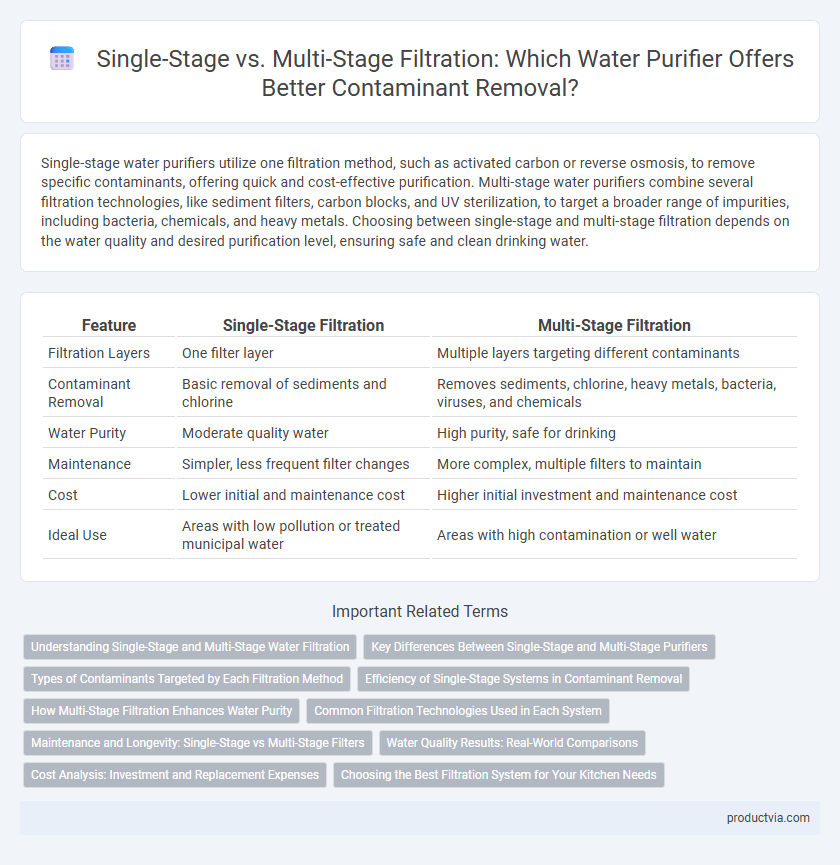Single-stage water purifiers utilize one filtration method, such as activated carbon or reverse osmosis, to remove specific contaminants, offering quick and cost-effective purification. Multi-stage water purifiers combine several filtration technologies, like sediment filters, carbon blocks, and UV sterilization, to target a broader range of impurities, including bacteria, chemicals, and heavy metals. Choosing between single-stage and multi-stage filtration depends on the water quality and desired purification level, ensuring safe and clean drinking water.
Table of Comparison
| Feature | Single-Stage Filtration | Multi-Stage Filtration |
|---|---|---|
| Filtration Layers | One filter layer | Multiple layers targeting different contaminants |
| Contaminant Removal | Basic removal of sediments and chlorine | Removes sediments, chlorine, heavy metals, bacteria, viruses, and chemicals |
| Water Purity | Moderate quality water | High purity, safe for drinking |
| Maintenance | Simpler, less frequent filter changes | More complex, multiple filters to maintain |
| Cost | Lower initial and maintenance cost | Higher initial investment and maintenance cost |
| Ideal Use | Areas with low pollution or treated municipal water | Areas with high contamination or well water |
Understanding Single-Stage and Multi-Stage Water Filtration
Single-stage water filtration systems typically use one type of filter media designed to target specific contaminants like chlorine or sediment, providing basic purification for household water. Multi-stage filtration combines several filter types such as sediment filters, activated carbon, and reverse osmosis membranes to remove a broader range of impurities, including heavy metals, chemicals, and pathogens. This layered approach enhances water quality by addressing multiple contaminants in sequence, ensuring cleaner and safer drinking water.
Key Differences Between Single-Stage and Multi-Stage Purifiers
Single-stage water purifiers use one filtration medium, typically activated carbon or sediment filters, targeting specific contaminants such as chlorine or particulates. Multi-stage purifiers combine several filtration technologies like sediment filters, activated carbon, reverse osmosis, and UV treatment to remove a broader spectrum of impurities including heavy metals, bacteria, and viruses. The key difference lies in multi-stage systems offering enhanced contaminant removal efficiency and improved water quality by sequentially addressing diverse pollutants.
Types of Contaminants Targeted by Each Filtration Method
Single-stage water purifiers primarily target large particles, sediment, and chlorine, effectively removing basic impurities like dirt and odors for improved taste and clarity. Multi-stage filtration systems combine different technologies such as activated carbon, reverse osmosis, and UV sterilization to eliminate a broader range of contaminants including heavy metals, bacteria, viruses, pesticides, and dissolved salts. This comprehensive approach ensures safer, cleaner drinking water by addressing complex chemical and biological pollutants that single-stage filters typically cannot remove.
Efficiency of Single-Stage Systems in Contaminant Removal
Single-stage water purifiers efficiently remove common contaminants like chlorine, sediment, and some larger particles through activated carbon or basic filtration media. Although they are less effective at eliminating dissolved solids, heavy metals, or microorganisms compared to multi-stage systems, single-stage filters offer a cost-effective solution for moderate purification needs. Their simplicity ensures faster water flow rates and easier maintenance, making them suitable for households with minimal water quality issues.
How Multi-Stage Filtration Enhances Water Purity
Multi-stage filtration enhances water purity by employing a series of targeted filters, such as sediment, activated carbon, and reverse osmosis membranes, to effectively remove a broad spectrum of contaminants including chlorine, heavy metals, bacteria, and viruses. Each stage specializes in eliminating specific impurities, resulting in higher overall water quality compared to single-stage systems that only address limited pollutants. This layered approach ensures comprehensive contaminant removal, delivering safer, cleaner drinking water.
Common Filtration Technologies Used in Each System
Single-stage water purifiers typically use activated carbon filters to remove chlorine, sediment, and some organic compounds, providing basic contaminant reduction. Multi-stage filtration systems combine multiple technologies such as activated carbon, reverse osmosis membranes, UV sterilization, and ion exchange resins to target a broader range of contaminants including heavy metals, bacteria, viruses, and dissolved solids. This comprehensive approach enhances water purity by sequentially addressing different types of impurities based on their chemical and physical properties.
Maintenance and Longevity: Single-Stage vs Multi-Stage Filters
Single-stage water purifiers offer simpler maintenance with fewer components to clean or replace, resulting in lower ongoing costs. Multi-stage filtration systems, while requiring more frequent filter changes due to multiple layers targeting different contaminants, generally provide enhanced longevity by preventing rapid clogging of individual filters. Proper upkeep of multi-stage filters extends overall system lifespan and ensures more effective long-term contaminant removal compared to single-stage units.
Water Quality Results: Real-World Comparisons
Single-stage water purifiers typically remove larger particles and basic contaminants but may leave behind dissolved chemicals and microorganisms, resulting in moderate water quality improvement. Multi-stage filtration systems, incorporating carbon filters, sediment filters, and reverse osmosis membranes, deliver significantly higher contaminant removal, including heavy metals, chlorine, bacteria, and viruses, ensuring superior water purity. Real-world comparisons reveal multi-stage purifiers consistently produce cleaner, safer drinking water, meeting stringent health standards and providing better taste and odor control.
Cost Analysis: Investment and Replacement Expenses
Single-stage water purifiers typically have lower initial investment costs but may require more frequent filter replacements, increasing long-term expenses. Multi-stage filtration systems involve higher upfront costs due to advanced technology and multiple filter types but often offer longer filter lifespan and better contaminant removal efficiency, potentially reducing replacement frequency. Evaluating total cost of ownership requires balancing purchase price against maintenance and replacement expenditures over the unit's operational life.
Choosing the Best Filtration System for Your Kitchen Needs
Single-stage water purifiers effectively remove basic contaminants like sediments and chlorine, making them suitable for areas with relatively clean water sources. Multi-stage filtration systems incorporate multiple filters such as activated carbon, reverse osmosis, and UV purification, providing comprehensive removal of heavy metals, bacteria, viruses, and dissolved solids, ideal for kitchens with highly contaminated water. Choosing the best filtration system depends on water quality analysis, budget, and specific health concerns, ensuring optimal purification tailored to your kitchen needs.
Single-Stage vs Multi-Stage Filtration for Contaminant Removal Infographic

 productvia.com
productvia.com